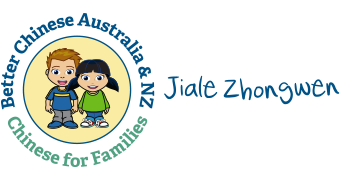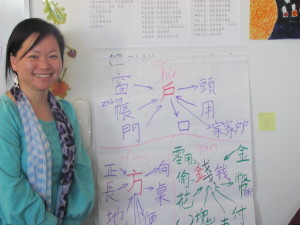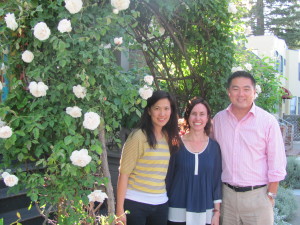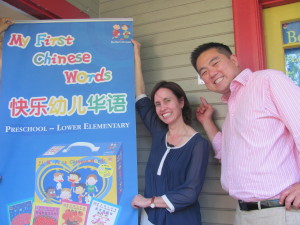Better Chinese and immersion schools in the US
This April I visited Better Chinese at their Palo Alto office in Silicon Valley, California. It was great to meet everyone in person and find out more about some exciting product developments. Better Chinese currently supports over 55% of Chinese language immersion programs in the United States so they organised some school visits for me. While I was there, we also discussed developments and programs in the Australia/New Zealand region.
Some exciting developments with Better Chinese include
- Modern Chinese has been adopted by a number of US universities including Northwestern University (world university ranking: 26).
- Better Chinese has been further developing their iPad app and e-book options. I will be able to share more details soon.
- Chinese language teaching continues to boom in the US and Better Chinese is well established as a leading publisher with over 1200 schools utilizing Better Chinese materials
Immersion Programs
There are currently around 126 Chinese immersion schools in the US. While I was in Palo Alto Better Chinese arranged for me to visit two elementary schools with outstanding Chinese immersion programs. I went with Li-Hsiang Yu Shen, the founder of Better Chinese who visited Sydney in 2011.
The first school we visited was the International School of the Peninsula (www.istp.org ), a private kindergarten to Grade 8 school offering both Chinese and French language immersion programs. We first met with Head of School Philippe Dietz and Assistant Head of School Kate Lussen who gave me a general overview of the program. In kindergarten 80% of the classroom time is in Mandarin. By Grade 4/5 50% of instruction time is in Mandarin, with Maths and Science taught in English at the higher year levels. In the early years, immersion students on average slightly underperform on standardised testing on English and Maths but by Grade 8 they are consistently outperforming their monolingual peers. Communicating and working with parents is essential so that non-Chinese speaking parents in particular know what is happening with their child’s education and can support at home in English. ISTP students are also expected to do between 2-4 hours of homework a night depending on the year level.
We visited a kindergarten and Grade 1 classroom and I also got the chance to speak with the Grade 3 teacher. Li-Hsiang Yu Shen had played a central role in setting up the program and training the teachers and was warmly welcomed in all the classrooms and offices we visited. In the kindergarten classroom it was mat time. It was amazing to see the teachers fully explaining the upcoming activities in Chinese with the children fully comprehending and responding in Chinese or mixed Chinese/English. In the Grade 1 class the children were doing addition and subtraction using an abacus in the full Chinese immersion environment. The teacher went around the room checking and asking students about their work in Chinese with language no impediment to the children’s mathematical learning. The Grade 1 students use adjacent Chinese and English classrooms. When they are with their Chinese teacher in the Chinese classroom they learn pinyin pronunciation and when they are with their English teacher in the English classroom they learn the English alphabet. Li-Hsiang Yu Shen and the teachers assured me that the children manage this easily with no problems.
I was particularly impressed with how effectively the students learn to read and write characters in the immersion environment. In the kindergarten the teachers use My First Chinese Words to develop students literacy. In the Grade 1 classroom all the information displayed such as the classroom rules, poster on tooth health and so on were all in characters. At ISTP students learn traditional characters until Grade 4/5 when they switch to simplified. The Grade 3 teacher showed me how she taught character analysis and also an example of student composition on an iPad. On the wall were also posters on the science topics of geometrical formations and bacteria.
The second school we visited was Ohlone Elementary School www.ohlone.pausd.org, a public Kindergarten to Grade 5 elementary school offering non-traditional community and student centred education with a strong emphasis on parental involvement. Ohlone also offers a Mandarin immersion program with Mandarin instruction time of 80% in Kindergarten/Grade 1, 60% in Grades 2/3 and 50% in Grades 4/5. As both the school itself and the immersion program are very popular, enrolment by students not living in the school zone is by lottery (with one lottery for the school and one for the immersion program in particular). The school deliberately chooses 35-50% of the students in the program to be native Chinese speakers to act as role models with the rest being non-native speakers.
Ohlone has a farm with not only gardens but many animals. On one morning that I was there, the kindergarten/Grade 1 class had Farm lesson where the Farm teacher taught the children (in English) about chickens. The students then returned to the main classroom where all instruction is in Chinese. There were beautiful farm displays fully labelled in Chinese characters and farm models the students had been making. On the whiteboard there was a chart with questions and answers about farm animals and the teacher told me 80% of the children could read all of the characters used. I also got the chance to observe mat time, where the teacher taught and gave instructions fully in Chinese with the students showing full comprehension and mostly responding in Chinese.
I also got the chance to observe a Grade 4/5 class. The teacher was talking to the students about Earth Day discussing topics such as the Earth Day founder and environmental problems at native speaker speed and vocabulary level with no language modification. From what I witnessed, the listening comprehension of the students was significantly higher than a typical Year 12 second language learner.
I was deeply impressed by the commitment to Mandarin language education at the two schools I visited and the skill of the teachers. I was amazed by the fluency and literacy level of the students, many of whom clearly had no Chinese heritage. I would like to thank the International School of the Peninsula and Ohlone Elementary School for allowing me to visit their schools and also Better Chinese for arranging these visits for me.




